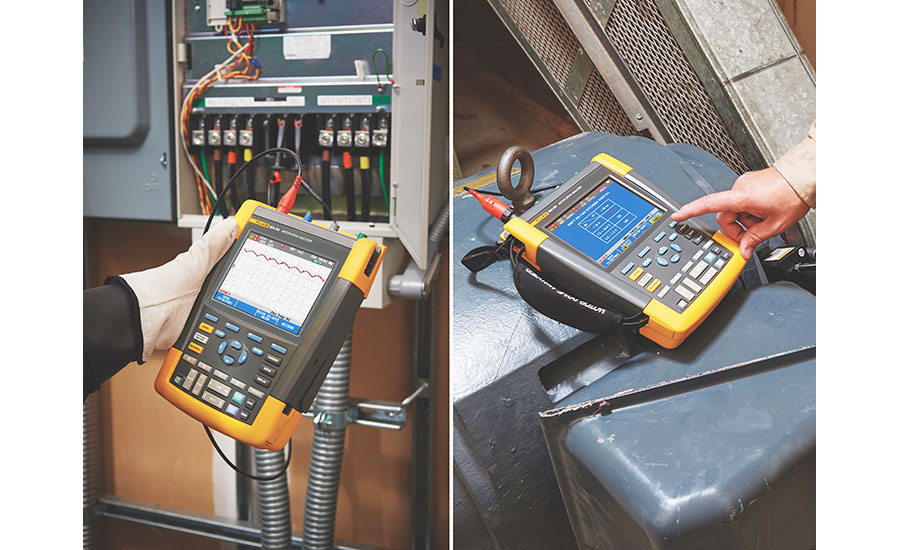Engineering R&D
Streamlining motor-drive analysis
Fluke’s motor drive analyzer helps new techs learn to use the instrument, saves experienced specialists setup time


Newly developed Fluke Model 550 Motor Drive Analyzer checks output waveform at the motor drive (left) and motor shaft voltages (right).
Photo courtesy of Fluke


With all the variable frequency motor drives in a modern food or beverage plant, knowing the level and quality of voltages and currents they’re sending to a motor could help a maintenance tech save the life of a motor. No one wants to keep replacing the same 20-hp motor again and again because excessive harmonics or voltage pulses killed it. Who can afford the downtime?
An engineer could drag an oscilloscope and a DVM to the motor drive(s), or now could leave them behind and use Fluke Corporation’s MDA-510 or MDA-550 Motor Drive Analyzer instead, which was released in October. The MDA-500 Series adds new, application-specific intelligence via instrument software to Fluke’s well-known workhorse, the ScopeMeter Test Tool.
The ScopeMeter Test Tool is a general-purpose instrument; the MDA-500 Series’ intelligence makes it much more suited to measure and observe motor-drives’ inputs, DC bus, outputs, motor input and motor shaft voltages—and keep all these measurements on record for later comparison.
I spoke with Fluke Corporation Senior Product Planner Erik Gervedink Nijhuis, who with his team of three engineers came up with a new solution to ease the process of taking motor-drive measurements and analyzing the results. Fluke’s group behind this new device is located in Almelo, Netherlands—about 100 miles east of Amsterdam.
FE: What inspired you to create a dedicated test instrument just for motor drives? Were installation and maintenance engineers looking for a dedicated, grab-and-go instrument?
Erik Gervedink Nijhuis: The main inspiration came from watching users in the field using the present ScopeMeter Test Tool in different application areas. We noticed that—especially for the applications involving variable frequency drives—the measurement setup was complicated and difficult even for the most experienced users. Furthermore, not all measurements could be accomplished using the available measurement functionality. That’s when we started to focus on the application area for a new development. The MDA-500 Series is actually not a dedicated instrument only for motor drive measurements, as it has all the oscilloscope and recorder functions included in the ScopeMeter Test Tool as well.
FE: How long was the motor-drive analyzer in development?
Gervedink Nijhuis: The total development time was nine months. In that period, we made several iterations to the functionality of the analyzer as we learned details about the applications in real-life situations. By testing with customers, we optimized and added functionality and improved ease of use along the way.
FE: So you basically took the general-purpose ScopeMeter Test Tool and turned it into an application-specific instrument? How did you do that?
Gervedink Nijhuis: The functionality of the tool is enhanced with all the motor drive functions that can be accessed using the Motor Drive Analyzer key, while keeping all the other existing functions. Software engineers implemented the new menu structure and additional algorithms required to perform the measurements. Using agile development, we refined several prototypes that were tested in the field and used for feedback to enhance the functions. Additionally, we updated the accessories that come standard with the product to better match the requirements of the application.
FE: The MDA-500 Series has “guided test measurements.” Can you explain how that works?
Gervedink Nijhuis: As a user, you first select the location of the measurement, for example at the motor drive output. Then you select the type of measurements you want to perform, such as current unbalance. The analyzer will display a connection diagram that shows where to connect the voltage probes and/or current clamps. An information screen can be selected that gives background information and tips concerning the selected measurement.
FE: Does the instrument suggest to the user that a drive may have a potential problem based on the voltages/currents it samples?
Gervedink Nijhuis: Information is provided in the info text screens; however, there is no good/bad indication. There are many factors influencing the waveforms and corresponding measurement readings like the type of drive, load conditions, etc. So there is still application expertise needed to analyze the results, but as the measurements are consistently performed in the same way, it is easy to compare and share with colleagues or experts.
FE: The instrument has built-in analysis and reporting. What types of reports can it generate?
Gervedink Nijhuis: Users tend to have different types of custom reports using standard text editors. What we provide is an easy way to save the screens of the tool to bitmaps and paste into the document. You give a set of measurements a name once on the tool and then every time a measurement is saved, the name of the file is automatically created based on the selected measurement.
FE: Can an engineer or tech make periodic, comparison checks of a drive? Would this be useful in tracking motor/drive performance to spot potential degradation over time?
Gervedink Nijhuis: When making reports, every time a drive is measured the comparison of each subsequent measurement can be made over time. However, to be able to spot potential degradation, differences in conditions must also be taken into account. As an example, the pulse width modulated signal on the motor drive output and motor input will typically vary over time, but parameters like overshoot in the signal can be an indication of potential degradation. By creating an “as found” report and “as left” report it’s easy for the user to see what the measurements should look like when tested later on.
FE: What’s the difference between the MDA-510 and MDA-550?
Gervedink Nijhuis: The MDA-550 has a number of additional expert level functions built in, such as harmonics, spectrum and motor shaft voltage measurements. To be able to measure the voltage on a rotating shaft, brush tips that are placed on top of the voltage probes are included, as well as a probe holder and magnetic base. Two additional current clamps are also included.
FE: Does the MDA-500 Series have storage on board? What about communications links?
Gervedink Nijhuis: The tool has internal memory and a USB drive can be connected to save and share reports.
A USB lead can be used to transfer the data to the PC, using FlukeView 2 for ScopeMeter Software. A stored report can be transferred just by selecting the name of the report and descriptions of each measurement can be added. All the selected measurement can then be printed or copied to a text editor for easy documentation.
FE: What’s the typical battery life between charges, assuming it’s in constant use?
Gervedink Nijhuis: A 52-Wh battery is used with specification up to 7 hours with low intensity use. With more intense use it will be closer to 4 hours, which is still enough for a typical day of use, as measurements are typically not done continuously during the day.
For more information, visit www.fluke.com
Looking for a reprint of this article?
From high-res PDFs to custom plaques, order your copy today!











